1993 PONTIAC GRAND-AM flat tire
[x] Cancel search: flat tirePage 190 of 306
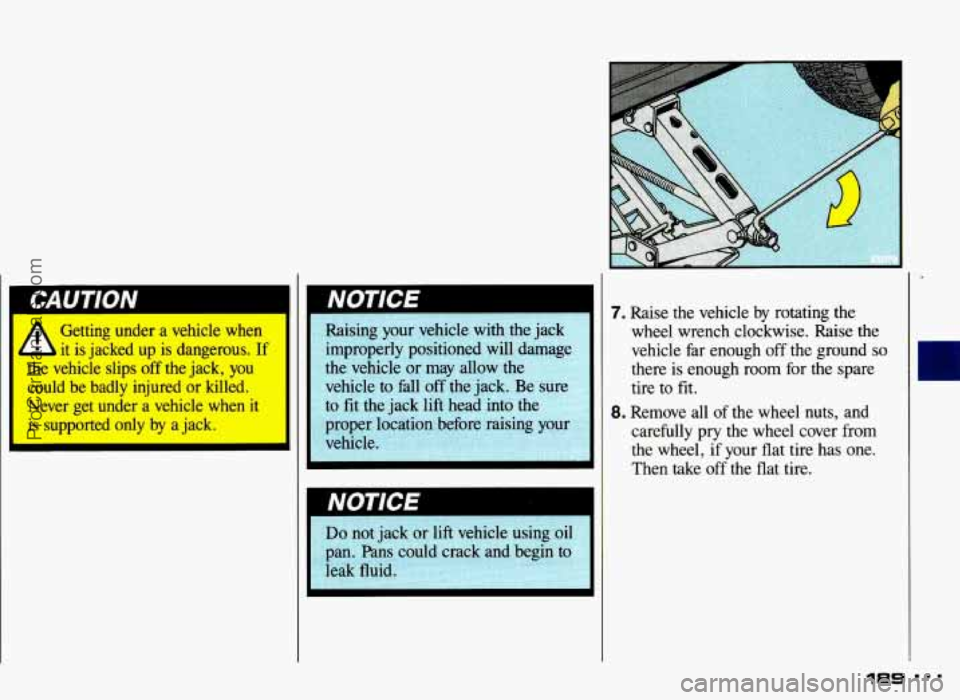
Ih Getting under a vehicle when
it is jacked up is dangerous. If
llle vehicle slips off the jack, you
could be badly injured or killed.
Never get under a vehicle when
it
is supported only by a jack. Raising your vehicle with the
jack
improperly positioned will damage
the vehicle or may allow
the
vehicle to fall off the jack. Be sure
to
fit the jack lift head into the
proper location before raising
vehicle.
Do not jack or lift vehicle using oil
pan. Pans could crack and begin to
leak fluid.
7. Raise tne venicle ~y rotating tne
wheel wrench clockwise. Raise the
vehicle far enough off the ground
so
there is enough room for the spare
tire to
fit.
8. Remove all of the wheel nuts, and
carefully pry the wheel cover from
the wheel,
if your flat tire has onp
Then take off
the flat tire.
189 I..
ProCarManuals.com
Page 191 of 306
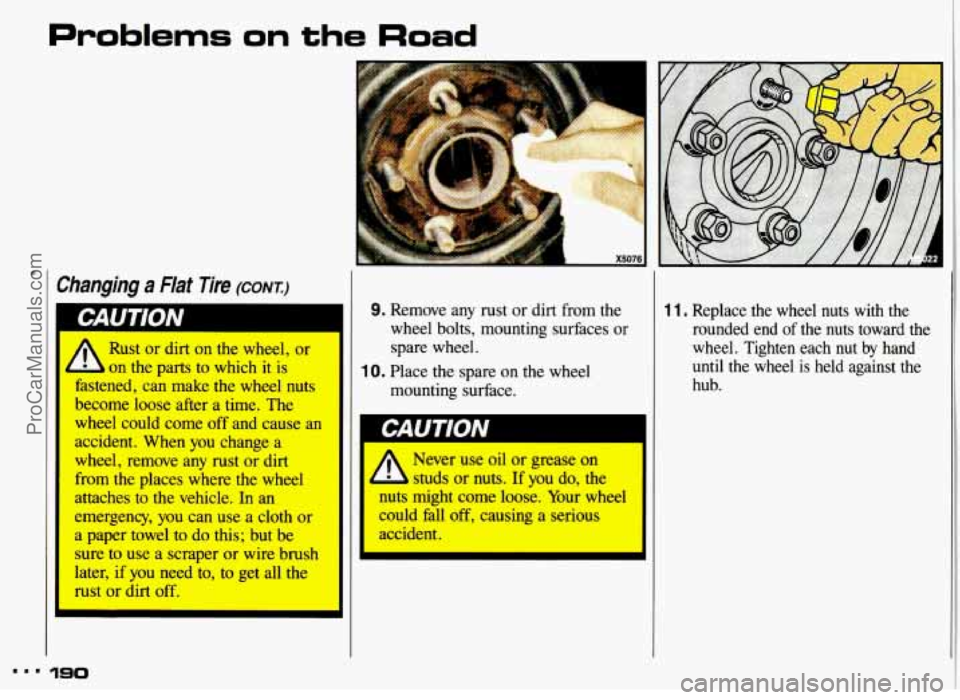
Problems on the Road
F"
'hanging a Flat Tire (CONT.)
f A Rust or dirt on the wheel, or
L on the parts to which it is
fastened, can make the wheel nuts
become loose after a time, The
wheel could come off and cause an
accident. When you change a
wheel, remove any rust or dirt
from the places where the wheel
attaches to the vehicle. In an
emergency, you can use a cloth or
a paper towel to do this; but be
sure to use a scraper or wire brush
later, if you need to, to get all the
rust or dirt off.
9. Remove any rust or dirt from the
wheel bolts, mounting surfaces or
spare wheel.
mounting surface.
10. Place the spare on the wheel
Never use oil or grease on
e b studs or nuts. If you do, the
nuts might come loose. Your wheel
could fall off, causing a serious
accident.
I
1 1. Replace the wheel nuts with the
rounded end of the nuts toward the
wheel. Tighten each
nut by hand
until the wheel is held against the
hub
..I 190
ProCarManuals.com
Page 192 of 306

12. Lower the vehicle by rotating the
wheel wrench counterclockwise.
Lower the jack completely. 13. Tighten the wheel nuts firmly in a
criss-cross sequence, as shown.
Incorrect wheel nuts or
- mproperly tightened wheel
nuts can cause the wheel to
become loose and even come
off.
This could lead to an accident. Be
sure to use the correct wheel nuts.
If
you have to replace them, be
sure to get the right kind.
Stop somewhere as soon as
you
can and have the nuts tightened
with a torque wrench
to
100 pound-feet (140 Nom). Don't
try to put a wheel cover on your
compact spare tire.
It won't fit. Store the
wheel cover and plastic cap nuts in the
trunk until you have the flat tire repaired
or replaced.
NOTICE
IS1
ProCarManuals.com
Page 193 of 306
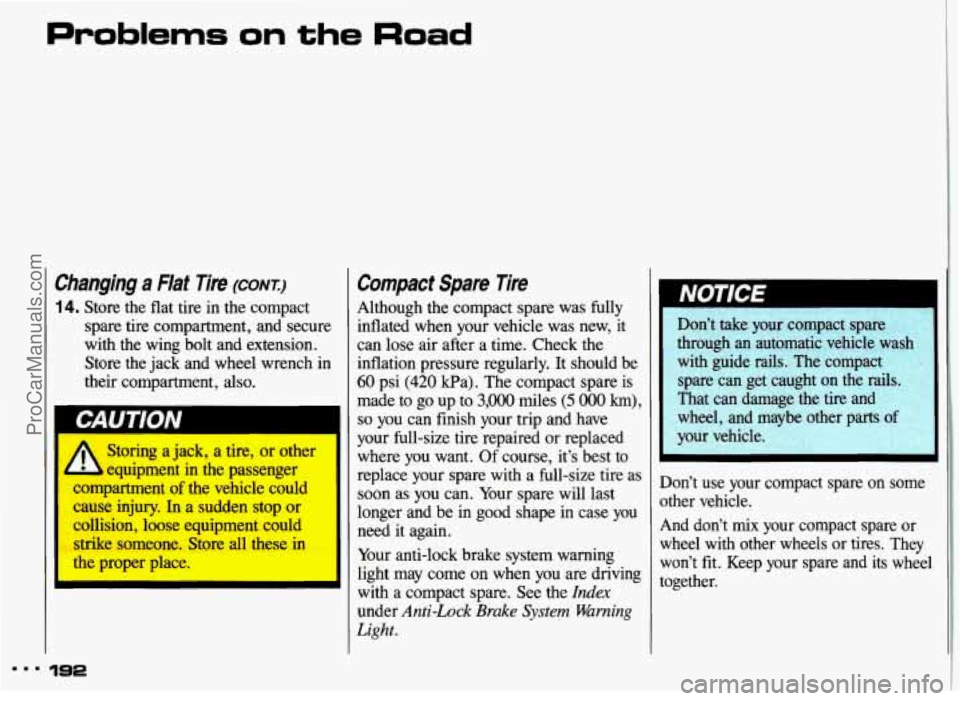
Changing a Flat Tire (corvr)
14. Store the flat tire in the compact
spare
tire compartment, and secure
with the
wing bolt and extension.
Store the jack and wheel wrench in
their compartment, also.
I A Storing a jack, a tire, or other
- equipment in the passenger
ompartment
of the vehicle could I
cause injury. In a sudden stop or
collision, loose equipment could strike someone. Store all these in
the proper place.
i
Compact Spare Tire
Although the compact spare was fully
inflated when your vehicle was new, it can lose air after a time. Check the
inflation pressure regularly. It should be
60 psi (420 Wa). The compact spare is
made to go up to
3,000 miles (5 O00 km),
so you can finish your trip and have
your full-size tire repaired or replaced
where you want.
Of course, it’s best to
replace your spare with a full-size tire as
soon
as you can. Your spare will last
longer and be in good shape
in case you
need it again.
Your anti-lock brake system warning
light may come on when you are driving
with a compact spare. See the
Idex
under Anti-Lock Brake System Warning
Light.
192
Don’t take your compact spare
through
an automatic vehicle wash I
with guide rails. The compact spare can get caught on the rails.
That can damage the tire and
wheel, and maybe other parts
of
your vehicle.
)on? use your compact spare on some
)ther vehicle.
ind don’t
mix your compact spare or
vheel with other wheels or tires. They
von’t
fit. Keep your spare and its wheel
ogether.
ProCarManuals.com
Page 231 of 306

Service & Appearance Care
Windshield Wiper Blade
Replacement
Replacement blades come in different
types and are removed in different ways.
Here’s how to remove the type with a
release clip:
1 . Pull the windshield wiper arm away
2. Lift the release clip with a
from the windshield.
screwdriver and pull the blade
assembly off the wiper arm.
the wiper arm.
3. Push the new wiper blade securely on
Loading bur Vehicle
Two labels on your vehicle show how
much weight it may properly carry. The
Tire-Loading Information label found on
the rear edge of the driver’s door tells
you the proper size, speed rating and recommended inflation pressures for the
tires on your vehicle. It also gives
you
important information about the number
of people that can be in your vehicle and
the total weight that you can carry. This
weight is called the Vehicle Capacity
Weight and includes the weight of all
occupants, cargo, and all nonfactory- installed options. The other label is the Certification
sticker, also on the rear edge of the
driver’s door. It
tells you the gross
weight capacity of your vehicle, called
the GVWR (Gross Vehicle Weight
Rating). The GVWR includes the
weight of the vehicle, all occupants, fuel
and cargo. Never exceed the GVWR for
your vehicle, or the Gross Axle Weight Rating (GAWR) for either the front or
rear axle.
And, if you do have a heavy load, you
should spread it out. Don’t carry more
than
132 lbs. (60 kg) in your trunk.
ProCarManuals.com
Page 233 of 306
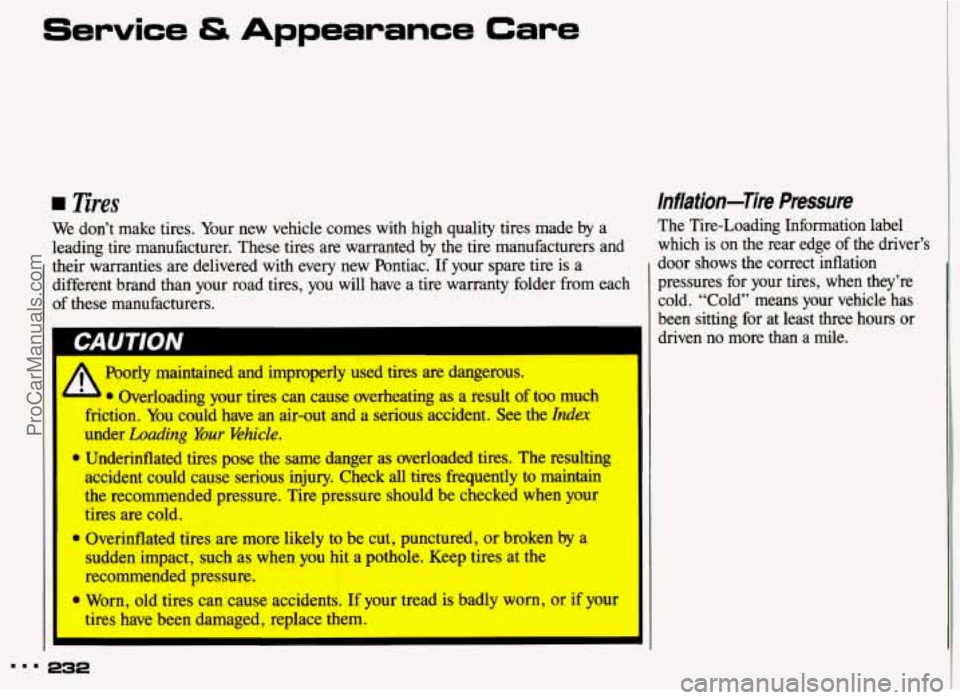
Service & Appearance Care
nres
We don’t make tires. Your new vehicle comes with high quality tires made by a
leading tire manufacturer. These tires are warranted by the tire manufacturers and
their warranties are delivered with every new Fbntiac. If your spare tire is a
different brand than your road tires, you will have a tire warranty folder from each
of these manufacturers.
Poorly maintained and improperly used tires dangerous.
a Overloading your tires can causy overheating as a result of too much
friction. You could have
an air-out and a serious accident. See the Index
under Loading Your Ehicle.
Underinflated tires pose the same danger as overloaded tires. The resulting
accident could
cause serious injury. Check all tires fiquently to maintain
the recommended presswe. Tire pressure should be checked when your
tires are cold.
Overinflated tires are more likely to be cut, punctured, or broken by a
sudden impacts such as when you hit a pothole. Keep tires at the
recommended pressure.
tires have been damaged, replace them.
m Worn, old tires can cause accidents. If your tread is badly worn, or if your
I I
lnflation-Tire Pressure
The Tire-Loading Information label
which is on the rear edge of the driver’t.
door shows the correct inflation
pressures for your tires, when they’re cold. “Cold” means your vehicle has
been sitting for at least three hours or
driven no more than a mile.
ProCarManuals.com
Page 234 of 306
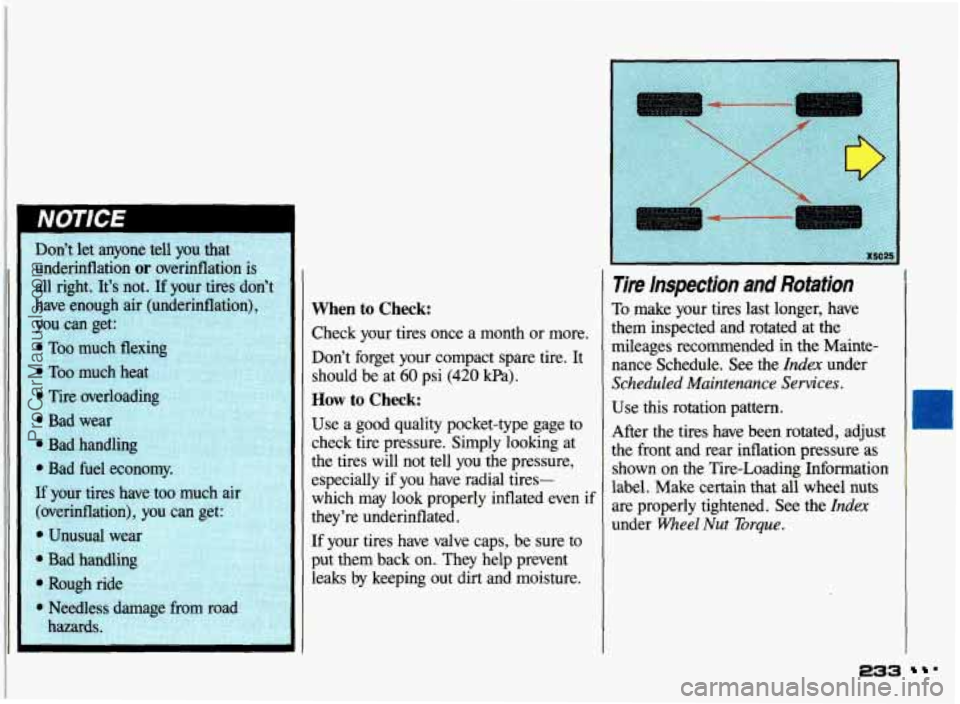
When to Check:
Check your tires once a month or more.
Don’t forget your compact spare tire. It
should be at
60 psi (420 kPa).
How to Check:
Use a good quality pocket-type gage to
check tire pressure. Simply looking at
the tires will not tell you the pressure,
especially if you have radial tires-
which may look properly inflated even if
they’re underinflated.
If your tires have valve caps, be sure to
put them back on. They help prevent
leaks by keeping out dirt and moisture.
lire inspection and Rotation
To make your tires last longer, have
them inspected and rotated at the
mileages recommended
in the Mainte-
nance Schedule. See the
Index under
Scheduled Maintenance Sewices .
Use this rotation pattern.
After the tires have been rotated, adjust
the front and rear inflation pressure as
shown
on the Tire-Loading Infomation
label. Make certain that all wheel
nuts
are properly tightened. See the Index
under Wheel Nut Torque.
233 .
ProCarManuals.com
Page 237 of 306
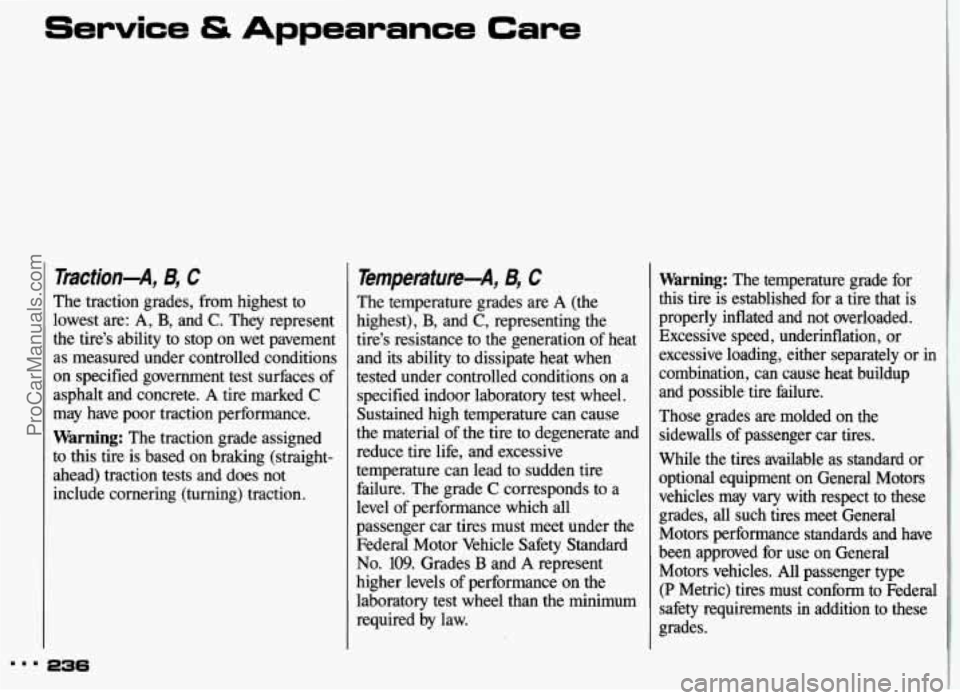
Traction-A, B, C
The traction grades, from highest to
lowest are:
A, B, and C. They represent
the tire’s ability to stop on wet pavement
as measured under controlled conditions
on specified government test surfaces of
asphalt and concrete.
A tire marked C
may have poor traction performance.
Warning: The traction grade assigned
to this tire is based on braking (straight-
ahead) traction tests and does not
include cornering (turning) traction.
Temperature-A, B, C
The temperature grades are A (the
highest),
B, and C, representing the
tire’s resistance to the generation of heat
and its ability to dissipate heat when
tested under controlled conditions on a
specified indoor laboratory test wheel.
Sustained high temperature can cause
the material of the tire to degenerate and
reduce tire life, and excessive
temperature can lead to sudden tire
failure. The grade
C corresponds to a
level of performance which all
passenger car tires must meet under the
Federal Motor Vehicle Safety Standard
No. 109. Grades B and A represent
higher levels of performance on the
laboratory test wheel than the minimum required by law.
Warning: The temperature grade for
this tire is established for a tire that is
properly inflated and not overloaded. Excessive speed, underinflation, or
excessive loading, either separately or in
combination, can cause heat buildup
and possible tire failure.
Those grades are molded on the sidewalls of passenger car tires.
While the tires available as standard or
optional equipment on General Motors
vehicles may vary with respect to these
grades,
all such tires meet General
Motors performance standards and have
been approved for use on General Motors vehicles. All passenger type
(P Metric) tires must conform to Federal
safety requirements in addition to these
grades.
ProCarManuals.com